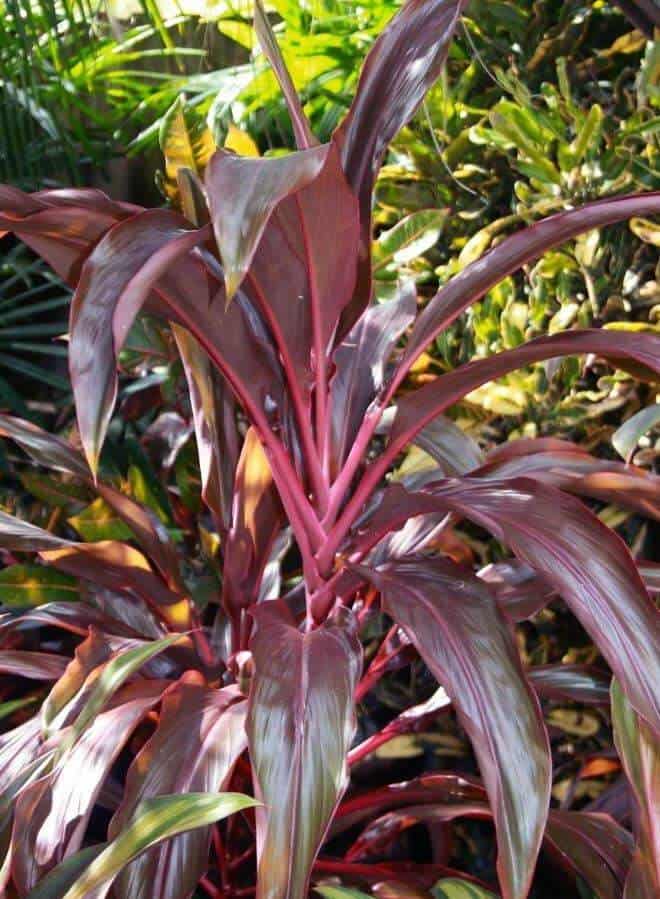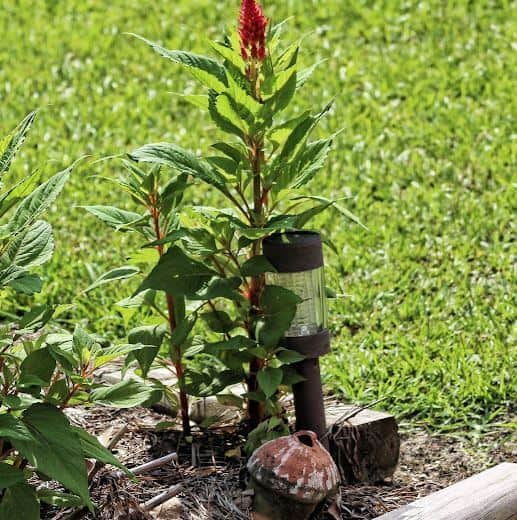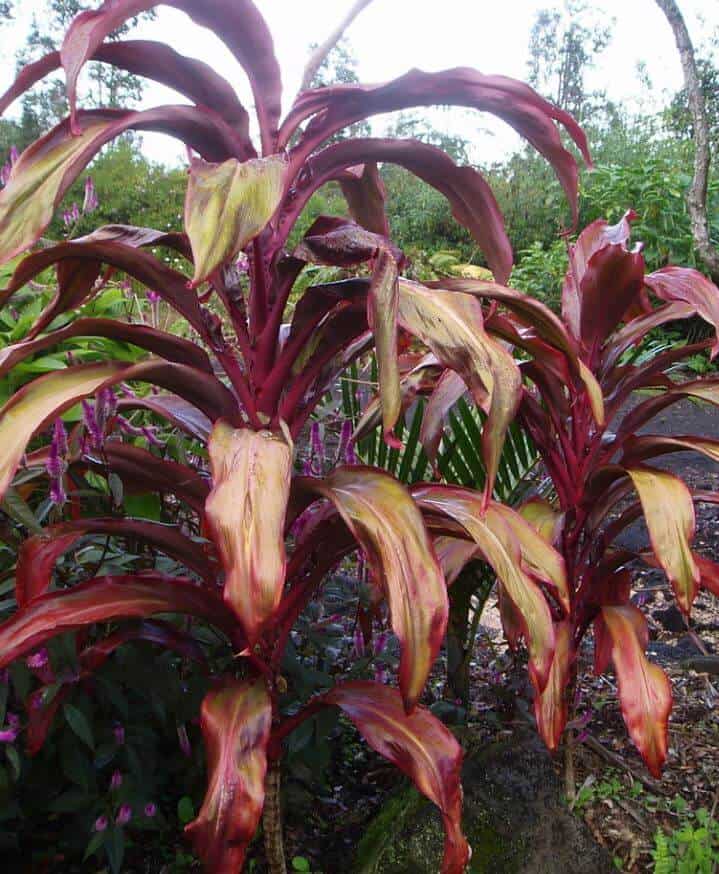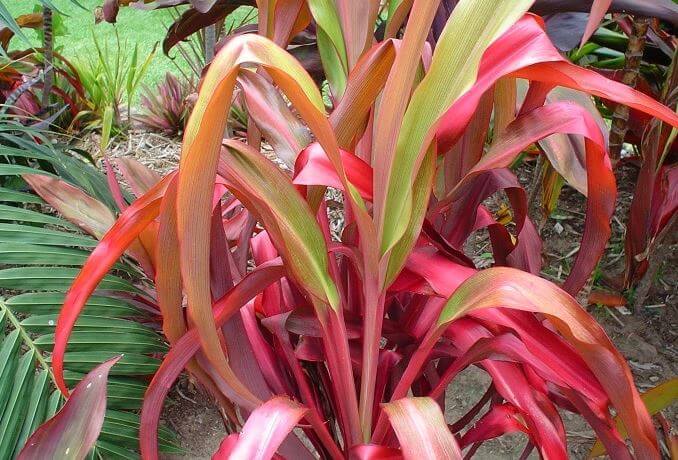Last Updated on January 6, 2023 by a Friendly Gardener
If too many plants have died on your watch, we get it—most of us aren’t blessed with natural thumbs of the green variety! Looking after plants takes time, effort, and care.
While the latter is non-negotiable, what can be negotiated is the amount of time and effort you put into raising your plants. Evergreen, easy-care, perennial plants are a godsend, in such cases—they don’t need much to thrive.
One such excellent option is the rooster tail plant. These versatile plants can be used as accents, planted in containers, and double up as (very pretty) ground cover. You’d also find it quite hard to kill them, even if you’re just a beginner!
If you’ve bought into the idea of this house plant, here’s everything you need to know about the rooster tail plant and rooster tail plant care.
What Are Rooster Tail Plants?

Also known as the good luck plant, Hawaiian ti plant, red rooster tail plant, and Cordyline plant (among many other names, rooster tails are flowering plants that belong to the Cordyline genus, which in turn belongs to the Asparagaceae family.
Scientifically, rooster tails are known as Cordyline fruticosa or Cordyline terminalis. These evergreen and perennial plants are native to the Pacific Islands, Island Southeast Asia, New Zealand, and Papua New Guinea, where they enjoy a culturally important position, especially among the native people in these regions.
These plants are used for a wide range of purposes by the tribes, from ornaments to medicine to food.
How Do Rooster Tail Plants Look?

Rooster tails reflect their tropical origins—these woody plants have stunningly colorful foliage, featuring shades of deep red, purple, pale pink, and/or green, depending on the variety.
The leaves are large, flexible, long (between one and two feet in length), leathery, and sword-shaped (with pointed ends), featuring variegation that combines the aforementioned colors.
The leaves also feature grooved petioles and almost always feature red—two characteristics that you can use to quickly ID these plants.
The plant’s leaves are also what earns it the name “rooster tail”, as the shape of the leaves resembles the tails of roosters. At their full height, these plants can measure between four and ten feet.
There are several Cordyline varieties available, each with differing leaf patterns, colors, and needs. However, all varieties are prized for their fast-growing, colorful, and long-lasting foliage.
Some varieties, if grown outdoors, may produce small pink, yellow, white, or lavender star-shaped blooms in spring, which develop into round, fleshy berries in shades of red, yellow, or green.
Rooster Tail Plants care

Though rooster tails don’t need much, a few steps will help your plant thrive in your garden, instead of merely surviving. You can grow these plants both indoors and outdoors (provided the conditions are right).
The below tips will help your rooster tail flourish.
Humidity and Temperature Requirements
Rooster tails, like most tropical plants, require ample sunlight and humidity.
These plants detest continuous exposure to temperatures below 50℉, so if you’re growing them indoors, ensure that you keep them away from spots where the temperature could consistently dip below this level, such as windows, doors, and cold spots, especially during the winter.
Brief exposure to temperatures between 30℉ and 50℉ won’t kill your rooster tail, but for it to grow well, temperatures between 65℉ and 95℉ are ideal.
When it comes to humidity, ensure that there’s a humidity level of at least 50% around your plant. If the air inside your house is extremely dry, there are several ways to increase the humidity, such as installing a humidifier, using a shallow dish filled with water and pebbles, and grouping your plants.
A hygrometer will help you measure the humidity levels inside.
Light Requirements
Striking the right balance of light can be tricky with rooster tails since these plants require ample sunlight, but excess exposure to sunlight can harm them.
Six hours or more of direct sunlight a day is necessary for rooster tails grown indoors, whereas, for outdoor plants, partial shade works well.
Indoors, you can place the plant near a sunny window or door, with the option of filtering the sunlight by drawing the curtains or blinds during the intensely hot afternoon hours. Outdoors, a shaded patio, porch, or balcony will work well.
Extremely intense sunlight can cause the leaf margins and tips to brown.
A good way to tell whether your plant is getting sufficient sunlight is to check its leaves. These plants tend to lose their color and variegation when they don’t receive sufficient sunlight, becoming greener.
If your indoor plant is losing color, you may need to supplement the existing lighting with additional artificial lights.
Water Requirements
When you water the plant, water it just enough to moisten the soil and not thoroughly soak it.
Though these plants are exposed to frequent rainfall in their native environments, watering them twice or thrice a week is sufficient during the growing season.
For adult plants, especially those grown indoors, wait till the top two inches of the soil are dry before you water again (water should exit through the pot’s drainage holes when you water the plant). If the plant is potted, watering once a week is sufficient.
Overwatering is among the leading causes of plant death around the world. Overwatering your plants will kill the roots through root rot, which is why it’s necessary to water right and also use well-draining soil.
Additionally, you could use a six-inch layer of mulch to prevent water from evaporating and keep the soil moist.
During the winter, watering once in two weeks is sufficient.
It’s important to note that rooster tails are highly sensitive to fluoride (the tips of the leaves turn brown), so using distilled water or rainwater, for watering, is recommended.
Soil and Fertilizer Requirements
Rooster tails thrive in soil that’s slightly acidic, is organically rich, and drains well, such as loamy, sandy soil, or well-draining potting mix. It’s highly important that the soil drains well, to prevent root rot from the accumulation of water/waterlogging. Sufficient drainage holes in the pot will also help prevent this.
When fertilizing, which should be done once every spring for outdoor plants and monthly for indoor plants, use slow-release pellets and water-soluble, diluted fertilizers, respectively. Avoid fertilizing during the winter months, as plant growth slows down during this period.
Repot once every two or three years, when the plant’s roots start to poke out through the drainage holes. As the plants mature and the growth rate slows down, you won’t need to repot as often.
Pruning and Propagating

Only basic pruning is required to get rid of any yellowed leaves and any wilting stalks. Propagation can be done through cuttings, seeds, and layering.
The Bottom Line
Rooster plants are great, fuss-free plants to have around. However, beware of common diseases and pests such as mealybugs, scale, fungus gnats, mites, and thrips. Regularly wiping down the leaves with a damp cloth and using insecticides will protect your plant.

